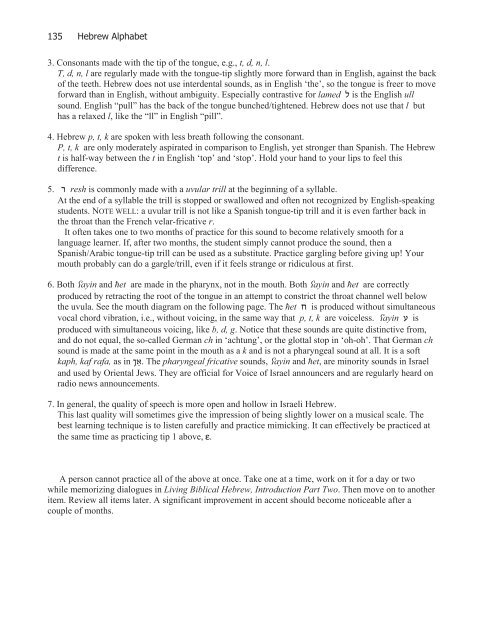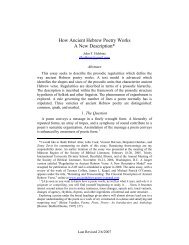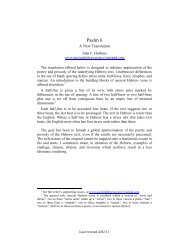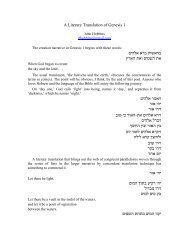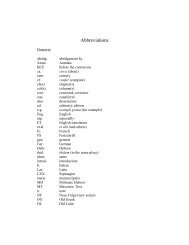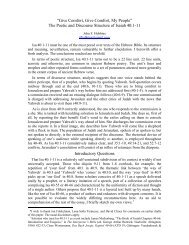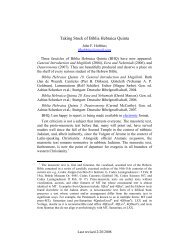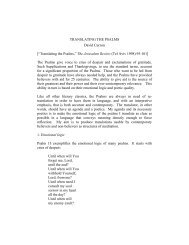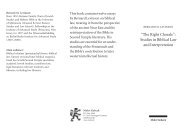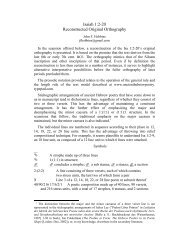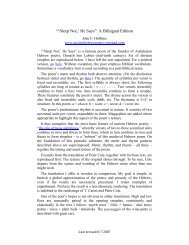Living Biblical Hebrew - Ancient Hebrew Poetry
Living Biblical Hebrew - Ancient Hebrew Poetry
Living Biblical Hebrew - Ancient Hebrew Poetry
Create successful ePaper yourself
Turn your PDF publications into a flip-book with our unique Google optimized e-Paper software.
135<strong>Hebrew</strong> Alphabet3. Consonants made with the tip of the tongue, e.g., t, d, n, l.T, d, n, l are regularly made with the tongue-tip slightly more forward than in English, against the backof the teeth. <strong>Hebrew</strong> does not use interdental sounds, as in English ‘the’, so the tongue is freer to moveforward than in English, without ambiguity. Especially contrastive for lamed is the English ullsound. English “pull” has the back of the tongue bunched/tightened. <strong>Hebrew</strong> does not use that l buthas a relaxed l, like the “ll” in English “pill”.4. <strong>Hebrew</strong> p, t, k are spoken with less breath following the consonant.P, t, k are only moderately aspirated in comparison to English, yet stronger than Spanish. The <strong>Hebrew</strong>t is half-way between the t in English ‘top’ and ‘stop’. Hold your hand to your lips to feel thisdifference.5. resh is commonly made with a uvular trill at the beginning of a syllable.At the end of a syllable the trill is stopped or swallowed and often not recognized by English-speakingstudents. NOTE WELL: a uvular trill is not like a Spanish tongue-tip trill and it is even farther back inthe throat than the French velar-fricative r.It often takes one to two months of practice for this sound to become relatively smooth for alanguage learner. If, after two months, the student simply cannot produce the sound, then aSpanish/Arabic tongue-tip trill can be used as a substitute. Practice gargling before giving up! Yourmouth probably can do a gargle/trill, even if it feels strange or ridiculous at first.6. Both ayin and et are made in the pharynx, not in the mouth. Both ayin and et are correctlyproduced by retracting the root of the tongue in an attempt to constrict the throat channel well belowthe uvula. See the mouth diagram on the following page. The et is produced without simultaneousvocal chord vibration, i.e., without voicing, in the same way that p, t, k are voiceless. ayin isproduced with simultaneous voicing, like b, d, g. Notice that these sounds are quite distinctive from,and do not equal, the so-called German ch in ‘achtung’, or the glottal stop in ‘oh-oh’. That German chsound is made at the same point in the mouth as a k and is not a pharyngeal sound at all. It is a softkaph, kaf rafa, as in . The pharyngeal fricative sounds, ayin and et, are minority sounds in Israeland used by Oriental Jews. They are official for Voice of Israel announcers and are regularly heard onradio news announcements.7. In general, the quality of speech is more open and hollow in Israeli <strong>Hebrew</strong>.This last quality will sometimes give the impression of being slightly lower on a musical scale. Thebest learning technique is to listen carefully and practice mimicking. It can effectively be practiced atthe same time as practicing tip 1 above, ε.A person cannot practice all of the above at once. Take one at a time, work on it for a day or twowhile memorizing dialogues in <strong>Living</strong> <strong>Biblical</strong> <strong>Hebrew</strong>, Introduction Part Two. Then move on to anotheritem. Review all items later. A significant improvement in accent should become noticeable after acouple of months.


